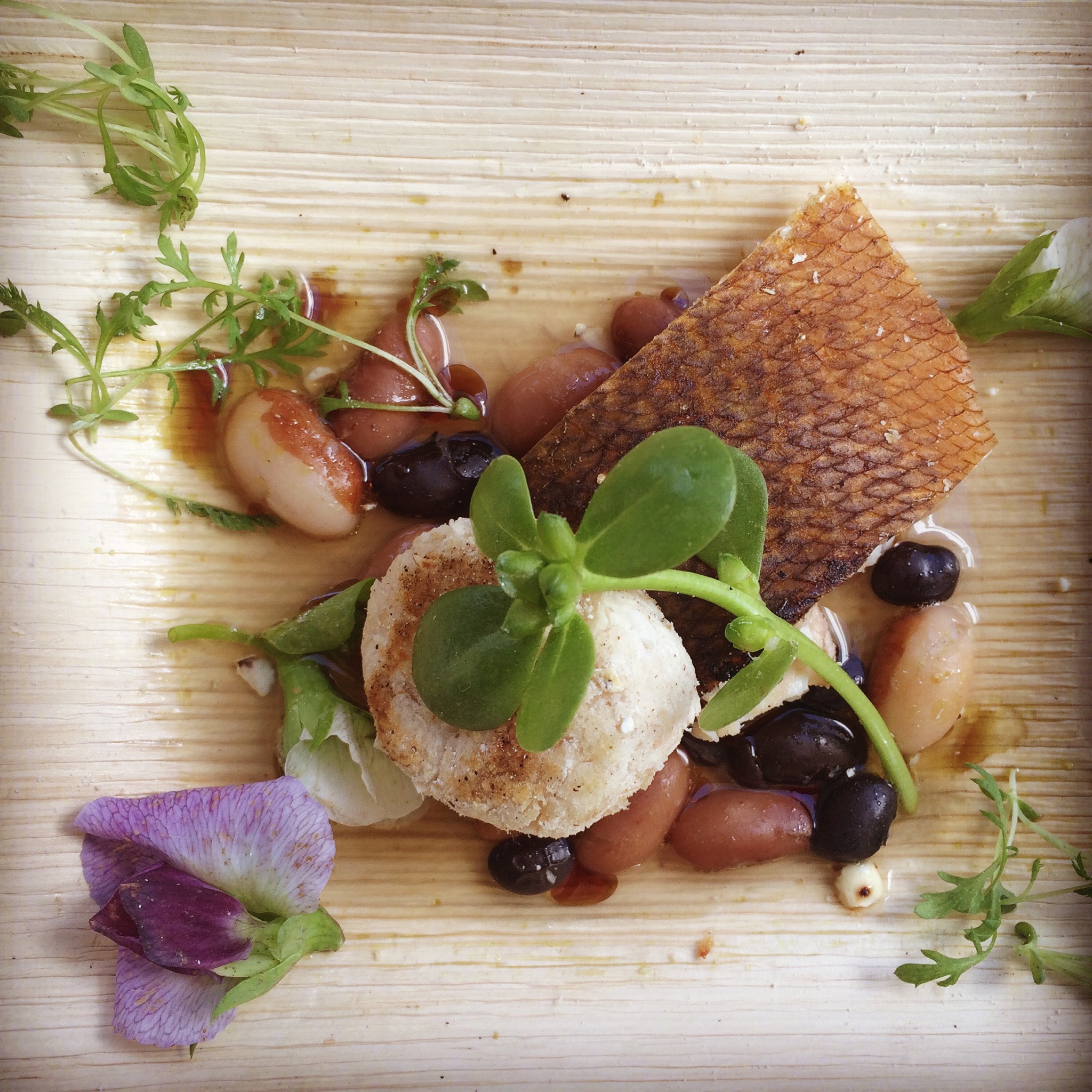Minnesota chef Sean Sherman, better known as The Sioux Chef, is getting back to his Native American culinary roots.
Sean Sherman is just back in the States after showcasing Native American food in Milan. There wasn’t a piece of fry bread in sight. Instead, there was smoked rabbit and duck. There was amaranth and purslane. His cooking techniques were modern, his plating contemporary. And the reception was enthusiastic. For this 41-year-old Oglala-Lakota chef, Italy was just one more stop on the road to reviving and popularizing pre-European-contact Native American food.
It’s been a lifelong journey. Better known as The Sioux Chef, Sherman began working in food services when he was 13 years old, after his family moved from the Pine Ridge Reservation to the town of Spearfish in the Black Hills of South Dakota. He continued to work in restaurants throughout high school and while working on a degree in business from Black Hills State College. Within three years of landing a job as a chef in Minneapolis, Sherman became the executive chef at La Bodega Tapas Bar in 2000. It was in Minneapolis that he began to develop his passion for indigenous cuisine.
“I started working with a lot of the local foods in the area,” he says. “I started getting a feel for working directly with the ranchers and farmers and exploring and getting to know a lot of the specialty varieties that people were growing.”
The next step seemed self-evident: If you want to cook the best local cuisine, you need the most local — or better yet, native — ingredients. Sherman began researching indigenous cuisine, scouring historical texts, and recording oral histories. “I had the vision of modern, artful plating of Lakota foods, but I really wanted to research backward and try to figure out what those ingredients were and stick as true to the foundation as possible.”
In September 2014 he established The Sioux Chef, a Minneapolis-based catering and educational enterprise focused on pre-contact foods of the Oglala-Lakota, Dakota, and Ojibwe tribes. He has gone into schools and cultural centers, conducted cooking demonstrations, and rolled out his own playfully named food truck, the Tatanka Truck, in cooperation with Minneapolis’ Little Earth of United Tribes community. In the process, Sherman has become an integral figure in a culinary movement that’s bringing deserved attention to modern, regional Native American food.

Cowboys & Indians: Your culinary journey clearly has a purpose beyond making a name for yourself. ...
Sean Sherman: For me, it’s not about becoming a famous chef and just trying for my own name and for my ego’s sake. It’s really about getting people to think about Native American food systems in general — getting not only Native people but also non-Native people to really think about their own culture directly and think about the roots of their food systems and look around them.
Some of these tribes, especially in Minnesota, have been in the same areas for quite a long time, and there’s so much rich food around them in the forests that comes and goes every year. A lot of our communities were taken away from our traditional food systems, so we’re no longer utilizing that foraging and gathering aspect. It’s such an important part. Animals are the easy part; you can guess which animals are indigenous and which have been around for a long time. I think if people really got to know the land again, [they’d discover] all these plants and fruits that have been around a lot of our families for a long time. It’s about becoming reacquainted with them.
C&I: What is most gratifying about reacquainting people with indigenous foods?
Sherman: The best part about the work that I’m doing is that it’s bringing food back to kind of its original state, which is just really healthy because it’s dropping the glycemic scale index points really, really low. It’s just easier to digest. It’s higher energy. If you look backward, before Native communities went on the European diets, I don’t think there was any tooth decay going on. And there wasn’t much diabetes or heart disease or obesity, for that matter. And if we slowly started moving toward these nutritional foods, especially in our school system, with the elderly programs, it’s only going to make people healthier and happier in general, just because it’s just cutting all of this core sugar product.
The trick is trying to figure out how to make these foods accessible to not only the public but to the Native communities. Some communities, like where I grew up, are extremely remote villages where they don’t have any food systems; they have to drive at least 45 minutes to get to a gas station. Then you have 95 percent of the food product that is all sugar, fat, and salt, and it’s not doing anybody good healthwise. So I’m trying to think outside the box and present and popularize these foods and bring them back around and make them accessible for all sorts of people.
C&I: How did you start your search for pre-European-contact Native foods?
Sherman: I began asking people in my family about food memories and really kind of looking at it through the chef’s perspective, looking for particular foods that were kind of free and clear of European influences. So things that felt authentic were what I was searching for. Also, I knew there was a really good grasp of wild foods in general because a lot of this food was medicine and food at the same time. I bought some botany books, trying to figure out what was in business in the regions that I was looking at.
When I first started, I was focused on everywhere from the Black Hills region all the way out to the Great Lakes region. Over time, when I moved back to Minnesota, I honed it down to just the Minnesota region, just to kind of keep it in a very specific region because there’s so much out there, because the landscape changes so quickly. [It became a matter of] getting a feel for wild foods, for plant identification, being outdoors, looking for things, playing with things, tasting things, trying to hit the seasons right.
And then just researching tons of history, looking at what were people writing about when they were first meeting up with these groups, anywhere from the mid-1500s all the way up to the 1800s. How people were living, how people were building food caches, how people were cooking with fire and stone — any mentions of the kind of food that they were utilizing. And that slowly just helped build all these pieces up into a bigger perspective.
C&I: What turned out to be key in your research?
Sherman: Finding books like Buffalo Bird Woman’s Garden — that really was such a great example of the pre-European style of food in general, the farming practices, the food preservation practices, and cooking techniques. Things like that helped me have a clear sight as to what I was looking for in other books.
I’m really trying to build the colors of Native American food systems. So I broke down the agriculture scene to see what the people were harvesting and growing, how they were doing it, if they’re using domesticated seeds or wild crops and seeds. And I got into ethnobotany and understanding plant identification. Understanding salt- and sugar-making techniques. Understanding food preservation techniques. Understanding, especially up here, how people are wintering and keeping their supplies — what was in typical pantries, and how it would differ if it was Ojibwe or Dakota or Lakota. What people were specializing in in their own regions, the regionality of their own foods.
From there it was trying to piece everything together and brush away all the European influences, to look at the Native American food system in general and build off of that foundation. I wanted to try to start from the ground up and make the food as authentic as possible by understanding what the foundation was.
C&I: Does one of your dishes particularly exemplify all of that?
Sherman: I’ve been focused on these particular regions, mostly the Ojibwe styles of food systems once they moved to Minnesota. How the Dakota were living and the differences of how the Lakota were living, moving around a lot more, what they were gathering and how people were trading.
For the most part, the food is pretty much un-modernist cuisine. It’s just real simple foods; I’m only using a couple of ingredients in pretty much everything. I’m not using any processed flour, I’m not using any processed sugar, and I’m not using any dairy. I’m not using any beef, pork, or poultry, with the exception of some duck eggs or quail eggs on occasion. And I’m really just kind of focused on trying to utilize a lot of dried foods and trying to build up that foundation.
It needs to taste good for a modern palate, especially for a highly European-style palate that everybody has for the most part. But we have so much food and so many flavors. I use a lot of tree products all the time, so I’m constantly seasoning things with things like fir tree and spruce and cedar, and just cooking with these flavors and making teas out of them and stocks out of them. And I utilize smoke because we’re cooking directly with wood, so I get a lot of that flavor into foods.
I’ve been doing a lot of fancy dinners and modern-style platings — making things look really pretty and a bit high-end. We have also done a lot of straight-up family-style stuff and just solid, good food. But I like to put a lot of thought into those plates, too. Some of these plates can really speak of one area — you could find every single ingredient on that plate within a mile radius. For example, I might have something that’s a lot more Ojibwe style, so there will be some smoked fish and some wild rice and maybe some cattail, maybe some blueberry, maybe some sunchoke, and maple syrup of some kind. I can build a whole plate out of just some of these pieces and almost narrow it down to a micro-region of one lake or something like that.
C&I: Do you have one go-to ingredient?
Sherman: We try to use a lot of the heirloom varieties of beans that some of the Native farmers are growing. We’re really trying to keep the doors wide open for any Native American food producers around the area.
There’s a couple of farms out here , Dream of Wild Health and Wozupi [Tribal Gardens], that are Native-run farms, and they’re starting to grow some heirloom varieties of corn, sunflower, beans, squashes, melons, things like that. During the season, I’m trying to grab things as they’re coming in. The season changes so fast throughout the entire year. It’ll start off with the spring vegetables, you got ramps, you got fiddlehead ferns, animals start coming back in, and then people are getting their garden setups.
Then berry seasons start to kick in, so it’s berry season after berry season. So it’s really jumping on a lot of these flavors and utilizing them as they roll through the season, and then also figuring out how to preserve them. We have a food dehydrator, so we can dry things out at a faster rate than just sun-drying them. But we try to dry out a lot of foods just to have them as a staple, to utilize them for other menus down the road. Some of the go-to pieces, for me, are maple sugar, cornmeal, beans, squash, and of course, the lake fish that’s all around here, the walleye and the northern pike. We get all that directly from Red Lake Fishery up north here, from the Red Lake Reservation. And just try to keep it real to a lot of the local regional Native producers.
C&I: It seems like the idea of indigenous foods is catching on. ...
Sherman: Definitely. I feel it. Chefs like Nephi Craig (White Mountain Apache) have felt it a lot. I think Loretta Barrett Oden (Citizen Potawatomi) is feeling it. I think all the people working on it — Lois Ellen Frank (Kiowa), for instance — all these people working with foods and all these other chefs around the country are really noticing a spike in interest.
It takes a little bit of explanation, but then people get it right away. Then they’re always like, “Why hasn’t this been done before? Why aren’t there a whole bunch of Native American restaurants all over the place?”
It’s an extremely popular movement coming around, and I think once we’re able to get some food trucks and restaurants out there, we should be able to see lots of Native restaurants across the country that focus on the regions. It would make the American landscape so much more interesting because it just changes so dramatically as you travel across the country. It’d be great to experience the foods of all these different regions and peoples.
For recipes, see the January 2016 issue.













